“It fascinates me that O’Neill and Miller write so badly. They could never have been novelists. But James, Dickens and Joyce were simply too eloquent and abundant in language for the stage. It may be that after Shakespeare the link between theater and language begins to fray.”
Harold Bloom (courtesy of Histriomastix)
Archives for December 2007
OGIC: Opera from the outside
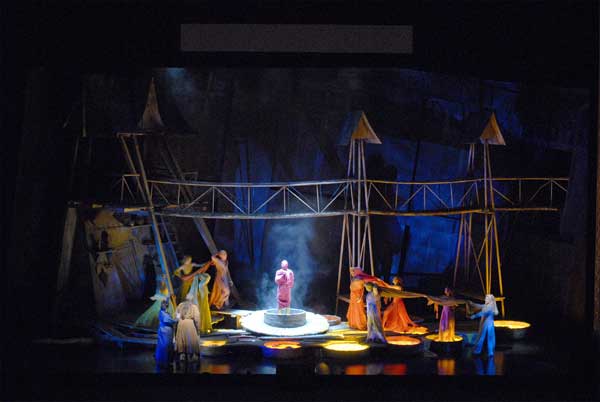 It was a cold, wet, nasty weekend in Chicago last weekend, so for the most part I stayed in. However, I was lured out from under several blankets on Saturday night by the Lyric Opera’s production of Richard Strauss’s Die Frau ohne Schatten (The Woman Without a Shadow).
It was a cold, wet, nasty weekend in Chicago last weekend, so for the most part I stayed in. However, I was lured out from under several blankets on Saturday night by the Lyric Opera’s production of Richard Strauss’s Die Frau ohne Schatten (The Woman Without a Shadow).
I love going to the opera but, to be honest, still can feel daunted on encountering an art form for which I lack any kind of competent critical apprehension or vocabulary. It’s not as if I actually believe that aesthetic appreciation depends on the capacity to interpret or assess the work before one–but the habits you pick up during several long years in humanities graduate school do tend to breed a little anxiety on this count.
Plus I’m out of practice lately, not having been to an opera in two or three years. So the four-hour running time attached to a work I knew nothing about gave me a tiny bit of pause–just the most fleeting question as to my own staying power and capacity to appreciate what I saw and heard.
Well, this is the Lyric Opera, and I needn’t have worried. While the story of Frau is an ornate fairy tale centered on procreation that seemed to me more than a little nuts (though reading Magda Krance’s well-informed précis here after the show was a great help in sorting it out), the sheer beauty of the music and the singing made me forget myself, as well as forgetting any anxiety I might have had about appreciating it properly. Deborah Voigt in the lead, a character who is transformed over the course of the opera, was most affecting, particularly in the joy she conveys with real power and yet with tremendous delicacy after she’s experienced her sea change. The whole thing, from the great voices assembled on one stage to the achingly beautiful orchestration to the fantastical set and choreography, was enough to make this reluctant operagoer embrace pure, unschooled aesthetic enjoyment again. (And if that isn’t enough to convince you, the genuine opera buff who accompanied me found it just as wonderful as I did.)
There are still a few performances of Frau on Lyric’s calendar, including one tonight. I’m told it’s seldom staged, and even less frequently with an orchestra as fine as the Lyric’s–so go to it, Chicago types. Find tickets here.
TT: Sursum corda
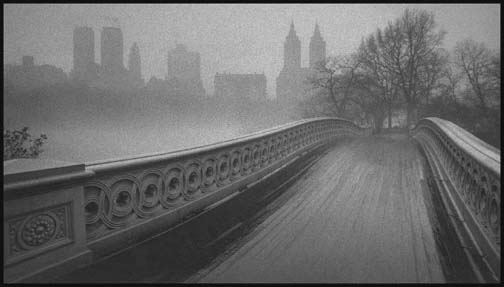 I’ve lived in or near Manhattan for close to a quarter-century, yet there are still moments when I catch myself feeling that the life I lead on the Upper West Side can’t possibly be real. I was walking back to my apartment one day last week when that sense of improbability swept over me without warning: how on earth did I end up living half a block from Central Park, reviewing Broadway plays for a living and popping into nightclubs and art galleries between deadlines? At various points along the way, I was sure I was going to be a lawyer, a high-school teacher, a jazz musician, and a psychotherapist, and I fully expected to pursue each of these professions within the borders of the Midwestern state where I was born. Instead I wake each morning, climb down from the cozy loft in which I sleep, turn on a small electronic device that in my youth was unimaginable save to science-fiction writers, and spend the day writing about the arts. I don’t live in a house, don’t own a car, don’t have a lawn to mow, don’t know any of my neighbors. I am, in short, a New Yorker, living an unreal life in an unreal city: I love it, but I don’t quite believe it.
I’ve lived in or near Manhattan for close to a quarter-century, yet there are still moments when I catch myself feeling that the life I lead on the Upper West Side can’t possibly be real. I was walking back to my apartment one day last week when that sense of improbability swept over me without warning: how on earth did I end up living half a block from Central Park, reviewing Broadway plays for a living and popping into nightclubs and art galleries between deadlines? At various points along the way, I was sure I was going to be a lawyer, a high-school teacher, a jazz musician, and a psychotherapist, and I fully expected to pursue each of these professions within the borders of the Midwestern state where I was born. Instead I wake each morning, climb down from the cozy loft in which I sleep, turn on a small electronic device that in my youth was unimaginable save to science-fiction writers, and spend the day writing about the arts. I don’t live in a house, don’t own a car, don’t have a lawn to mow, don’t know any of my neighbors. I am, in short, a New Yorker, living an unreal life in an unreal city: I love it, but I don’t quite believe it.
Later that same day I hailed a cab (a curious thing in and of itself for a small-town boy to do) and went to the Metropolitan Museum, which is directly across Central Park from the street where I live. I went there not to look at paintings but to hear a concert by Chanticleer, the twelve-man San Francisco vocal group that is currently celebrating its thirtieth anniversary. Each December they give a series of Christmastime concerts at the Met, and their president, who is a friend of mine, invited me to come hear them this time around. I accepted her offer weeks ago, long before the stagehands of Broadway went on strike, not knowing that the settling of the strike would force me to spend several nights in a row going to plays and that I would have to attend one of them, Conor McPherson’s The Seafarer, on the same night that Chanticleer was singing. I didn’t want to miss the concert and couldn’t reschedule the play, so I decided to see them both.
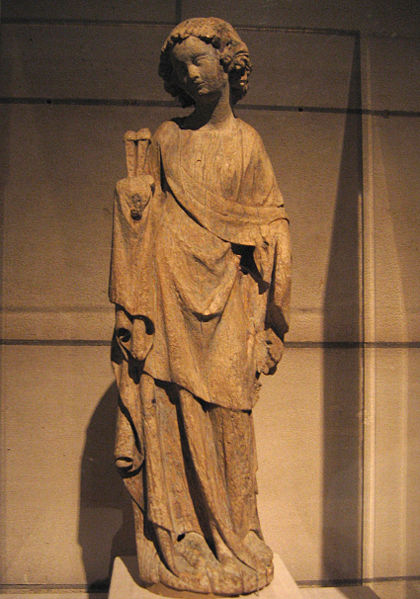 I got to the Met at six-fifteen and found a seat in the back of the gallery where the concert was to take place, a huge hall packed with pre-Renaissance European art. A vitrine three feet from my elbow housed an exquisitely wrought oak sculpture of an angel carved in the thirteenth century, around the same time that the first piece on the program, a motet by Perotin, was composed. As I gazed at the angel and listened to the harsh, briny, bracingly angular sounds of “Alleluia nativitas,” two sentences flashed through my mind. One was said by the Hungarian composer Miklós Rózsa: “I have no time for any music which does not stimulate pleasure in life, and, even more importantly, pride in life.” The other is the terrible line of Thomas Kyd that T.S. Eliot quoted at the end of “The Waste Land”: These fragments I have shored against my ruins.
I got to the Met at six-fifteen and found a seat in the back of the gallery where the concert was to take place, a huge hall packed with pre-Renaissance European art. A vitrine three feet from my elbow housed an exquisitely wrought oak sculpture of an angel carved in the thirteenth century, around the same time that the first piece on the program, a motet by Perotin, was composed. As I gazed at the angel and listened to the harsh, briny, bracingly angular sounds of “Alleluia nativitas,” two sentences flashed through my mind. One was said by the Hungarian composer Miklós Rózsa: “I have no time for any music which does not stimulate pleasure in life, and, even more importantly, pride in life.” The other is the terrible line of Thomas Kyd that T.S. Eliot quoted at the end of “The Waste Land”: These fragments I have shored against my ruins.
I’ve been to several of Chanticleer’s Christmas concerts at the Met, but the one I remember best is the one I heard six winters ago and wrote about shortly afterward in the Washington Post:
On the Sunday after the World Trade Center crumbled into dust, I flew over the southern tip of Manhattan, transfixed by the insensate spectacle far below me, gaping in dumb wonder at the black hole in my city–my home.
I have been thinking about that terrible day as I look back on the arts in New York in 2001. Somewhat to my surprise, I find it hard to recall what I saw a month ago, much less before September 11. It’s as if the hole had been burned not just in the city, but in time itself….
So instead of dwelling on the year’s highlights, I’ve chosen to embrace the present moment and the immediate experience. “One greatly needs beauty when death is so close,” old King Arkel sings in Debussy’s Pelléas et Mélisande. At last I understand what he meant: I went out nearly every night in December, searching for beauty, and most nights I managed to find some.
I can’t imagine anything more purely beautiful, for instance, than Chanticleer singing in the shadow of the Northern European Christmas tree at the Metropolitan Museum of Art. These annual concerts by San Francisco’s celebrated all-male chorus have become one of New York’s toughest holiday tickets (I overheard somebody complaining that the early show was sold out six months in advance), and now I know why. Take twelve men who sing exquisitely in tune and put them in a biggish room with a high, vaulted ceiling–like a church, but not as boomy–and you get sounds that shimmer and cling like handbells on a chilly day.
My companion that evening was a young woman who had come to New York to seek her fortune as a jazz singer. We met in March and immediately became friends, and in the nervous weeks after 9/11 we went to many concerts together, looking for the comfort that great art can give. Since then my friend has moved to California, but she came back to Manhattan two months ago to sing Stephen Sondheim’s “Anyone Can Whistle” at my wedding, and as Chanticleer filled the Medieval Sculpture Hall with the iridescent sounds of Praetorius, Josquin, Arvo Pärt, and Anton Bruckner, I remembered how we’d sat in that same room six years before, wondering what was to become of the city of our dreams.
I slipped out of the hall as the audience applauded “Es ist ein Ros’ entsprüngen,” collected my coat and shoulder bag from the checkroom, trotted down the front steps to Fifth Avenue, jumped into a cab, and headed for Broadway. Twenty minutes later I was sitting on the aisle of the Booth Theatre, a handsome 1913 building that is, like the Metropolitan Museum, something of a monument to the culture that came under attack on 9/11. The Booth has housed a long list of celebrated shows, among them You Can’t Take It With You, The Time of Your Life, Come Back, Little Sheba, A Taste of Honey, The Birthday Party, and Sunday in the Park With George. To date I’ve reviewed eight plays there, including the 2006 revival of Brian Friel’s Faith Healer that starred Ralph Fiennes and was directed by Jonathan Kent, who will be staging The Letter for Santa Fe Opera in 2009.
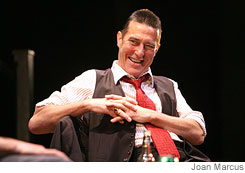 Like Faith Healer, The Seafarer is an Irish play that touches on matters supernatural, and its characters, as I wrote in last Friday’s Wall Street Journal, are “frustrated men whose lives have come to naught.” But it ends almost happily, which took me very much by surprise. As Daniel Patrick Moynihan remarked after John Kennedy was assassinated, “I don’t think there’s any point in being Irish if you don’t think the world is going to break your heart eventually.” Needless to say, you don’t have to be Irish to know that, but life without hope is hardly livable, and in a way the most remarkable thing about The Seafarer is that it holds out the prospect–however remote and unsure–of redemption.
Like Faith Healer, The Seafarer is an Irish play that touches on matters supernatural, and its characters, as I wrote in last Friday’s Wall Street Journal, are “frustrated men whose lives have come to naught.” But it ends almost happily, which took me very much by surprise. As Daniel Patrick Moynihan remarked after John Kennedy was assassinated, “I don’t think there’s any point in being Irish if you don’t think the world is going to break your heart eventually.” Needless to say, you don’t have to be Irish to know that, but life without hope is hardly livable, and in a way the most remarkable thing about The Seafarer is that it holds out the prospect–however remote and unsure–of redemption.
As I watched the final scene of The Seafarer unfold before my astonished eyes, I thought once more of what Miklós Rózsa said about the pride in life that art can make us feel. Two hours earlier I had listened with awe to a piece of music written seven hundred years ago, and looked with delight upon a wooden statuette so beautiful that generation upon generation of owners had felt moved to preserve it, until it made its way at last into a great museum, there to be preserved for all time–or until some life-denying madman should find a way to burn down the city that is its home.
Hope, Dr. Johnson tells us, is “a species of happiness, and, perhaps, the chief happiness which this world affords: but, like all other pleasures immoderately enjoyed, the excesses of hope must be expiated by pain; and expectations improperly indulged must end in disappointment.” He was wrong about few things, and this was not one of them. Yet I felt the purest, truest kind of hope on the night that I listened to “Alleluia nativitas,” looked at “Angel Holding the Instruments of the Passion,” and watched The Seafarer, and though I have no doubt that the world will break my heart a few more times before it is done with me, I find that knowledge–at least for now–unexpectedly easy to bear.
* * *
The Gregorian Chant Group at Stony Brook sings Perotin’s “Alleluia Nativitas”:
TT: Almanac
“Hope is definitely not the same thing as optimism. It is not the conviction that something will turn out well, but the certainty that something makes sense, regardless of how it turns out.”
Václav Havel, Disturbing the Peace
TT: Film at five-thirty
A cameraman from WCBS-TV is taping me as I type these words.
Here’s the backstory: No sooner did I return home from this morning’s press conference at Avery Fisher Hall than I got a call from a TV producer who wanted to know if I’d do an on-camera interview about the New York Philharmonic’s visit to North Korea for Channel 2’s five-thirty newscast. I said I’d talk to them if (A) they sent the camera crew to my apartment and (B) the interview was wrapped up by three o’clock. (I’m taping a Contentions videoblog this afternoon.) The producer agreed, and an hour later Deborah Garcia was knocking on my door.
Once we’d finished taping the interview, Deborah’s cameraman asked if he could shoot what in the TV news business is known as B-roll. He suggested that I walk into my office, sit down at my desk, and spend a minute or two clacking away on my laptop. I decided that it would be way meta if I were to blog on camera, which is what I’m doing.
To see how much of the interview (if any) makes it onto the air, tune into WCBS at 5:30 ET and cross your fingers. If you don’t live in or near New York City, you can go here to watch me–or not–in streaming video.
TT: The Philharmonic in Pyongyang
I just got back from a press conference at Lincoln Center’s Avery Fisher Hall at which the New York Philharmonic officially announced its plans to play in Pyongyang on February 26. Present were Paul Guenther, the orchestra’s chairman; Zarin Mehta, the orchestra’s president and executive director; and Pak Gil Yon, North Korea’s ambassador to the UN. Christopher Hill, an assistant secretary of state in the U.S. State Department’s Bureau of East Asian and Pacific Affairs, was also supposed to be at the press conference, but sent his apologies, claiming that “responsibilities” in Washington prevented him from attending.
Highlights:
• The Philharmonic will spend two and a half days in North Korea. During that time it will give a single concert in Pyongyang in a hall seating 1,500 people. It will then fly to Seoul, the capital of South Korea, to give a second concert there.
• Lorin Maazel, the orchestra’s music director, will conduct both performances.
• The Pyongyang program will consist of Gershwin’s An American in Paris and Dvorak’s “New World” Symphony, plus the national anthems of the U.S. and North Korea. Beethoven’s Fifth Symphony will be played in Seoul.
• According to a statement released earlier this morning, the Philharmonic is making the trip with “the encouragement and support of the U.S. Department of State.”
• Paul Guenther said that the orchestra’s “somewhat unusual journey” to North Korea would be a reflection of its “calling to serve, which the New York Philharmonic has never shied away from.”
• The concert will be broadcast, but as of this morning Zarin Mehta had no information on whether or how it would be heard inside North Korea, or who will be permitted to attend the performance. “I would guess they do not have the kind of system we have of advertising concerts and selling them,” he said.
• Fifty members of the international media will accompany the orchestra to Pyongyang. Mehta does not know what restrictions will be placed on them by the North Korean government.
• The orchestra wants to give master classes in Pyongyang for “music students and other professionals,” but so far no final arrangements have been made to do so.
• Ambassador Pak dodged the question of whether news of the concert has been released by North Korea’s state-controlled media as of this hour.
• Asked whether the concert would be a propaganda coup for North Korea, Mehta replied, “We’re not going to do any propaganda.”
• More quotes from Mehta:
“One small symphony is a giant leap.”
“All we can do is show the way that music can unite people.”
“We’re going there to create some joy.”
* * *
To read “Serenading a Tyrant,” my original October 27 Wall Street Journal column on the Philharmonic’s trip to Pyongyang, go here.
TT: Cram course
Dear OGIC and CAAF:
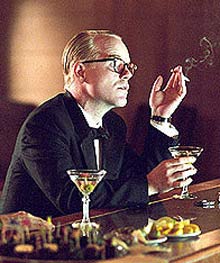 As you know, I haven’t watched a film in a theater since Capote, and the only new films I saw on TV during that long interregnum were Coeurs, about which more below, and Little Miss Sunshine. (Things were a little hectic!) After I went to a screening of Sweeney Todd last week, I decided that the time had finally come to find out what I’d been missing. To this end, would both of you please be so kind as to post lists of the ten films released since the fall of 2005–current releases included–that you think Mrs. T and I might like best?
As you know, I haven’t watched a film in a theater since Capote, and the only new films I saw on TV during that long interregnum were Coeurs, about which more below, and Little Miss Sunshine. (Things were a little hectic!) After I went to a screening of Sweeney Todd last week, I decided that the time had finally come to find out what I’d been missing. To this end, would both of you please be so kind as to post lists of the ten films released since the fall of 2005–current releases included–that you think Mrs. T and I might like best?
No spinach, please: I’m out for pleasure, very broadly construed, so don’t send me to anything I “ought” to see (whatever that means) unless it’s also something that you loved.
For purposes of calibration, the last ten then-new movies I watched with pleasure on a large screen were Bright Young Things, Capote, Collateral, Garden State, The Incredibles, Junebug, The Life Aquatic with Steve Zissou, Look at Me, Me and You and Everyone We Know, and Sideways.
Over to youse.
TT: Words to the wise
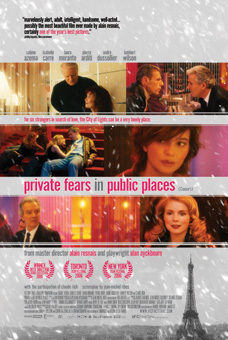 Seeing as how I’m on an Alan Ayckbourn kick, I wanted to let you know that Coeurs, Alain Resnais’ 2006 French-language film version of Ayckbourn’s Private Fears in Public Places, is showing this week on IFC.
Seeing as how I’m on an Alan Ayckbourn kick, I wanted to let you know that Coeurs, Alain Resnais’ 2006 French-language film version of Ayckbourn’s Private Fears in Public Places, is showing this week on IFC.
The play, which received its American premiere off Broadway in 2005, is one of Ayckbourn’s most important works, and even though Resnais’ bittersweet screen adaptation is very French, it’s surprisingly faithful to the original and more than worth seeing in its own right. To read what I wrote about it earlier this year, go here.
Six showings are scheduled:
• Tonight at 11:05 p.m. ET
• Wednesday at 5:25 a.m. and 3:05 p.m. ET
• Saturday, December 22, at 11:40 a.m. and 5:05 p.m. ET
• Sunday, December 23, at 4:55 a.m. ET
For more information about Coeurs, or to view the trailer, go here.
